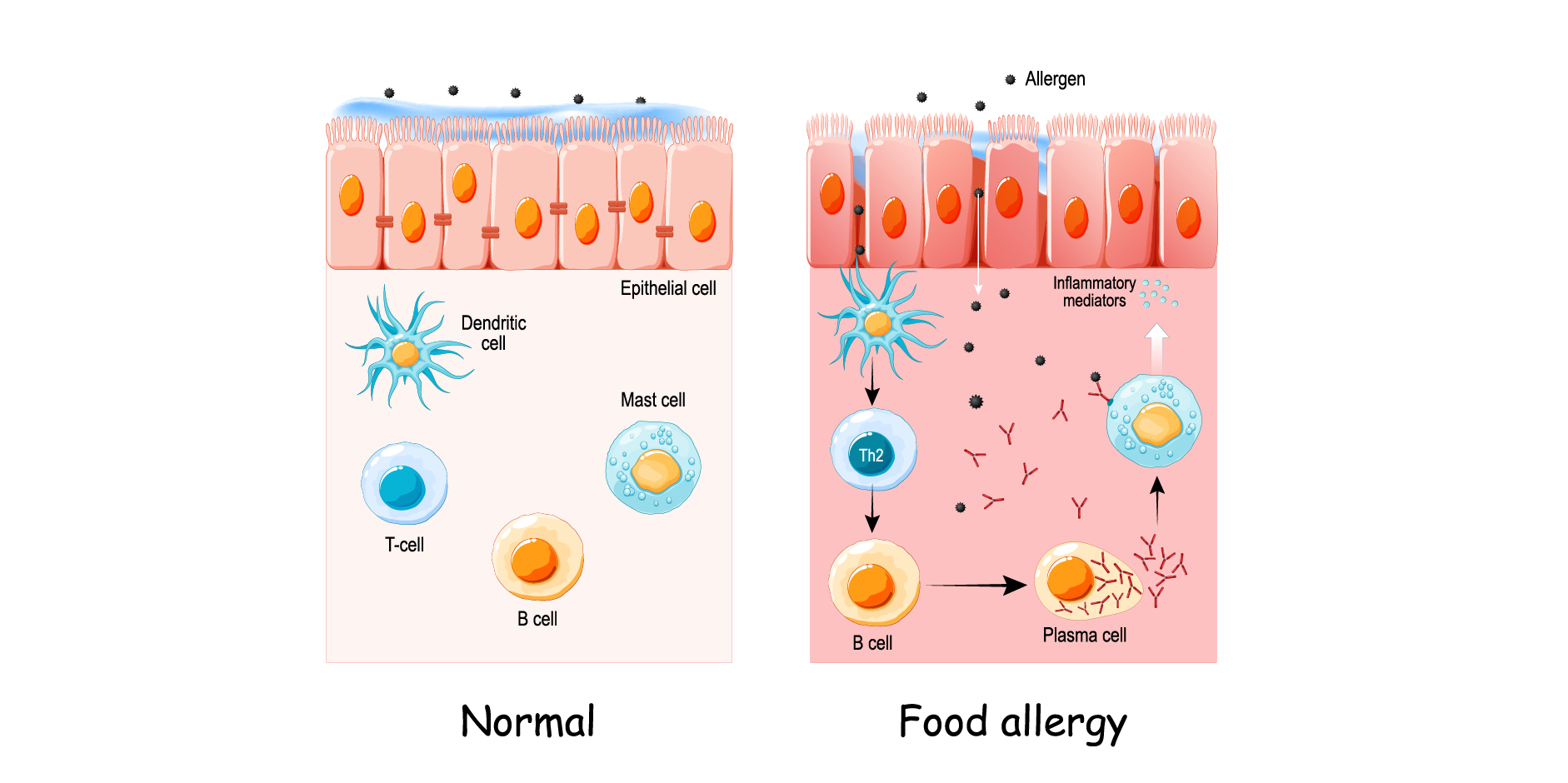Content on this page:
Content on this page:
Introduction
 Food Allergy (Pediatric)_Disease Background 1
Food Allergy (Pediatric)_Disease Background 1Food allergy is an adverse reaction that is due to a specific immune response occurring reproducibly upon exposure to certain foods. This may be life-threatening and is the most common cause of anaphylaxis in children. This should be differentiated from food intolerance, in which adverse reactions from exposure to food arise from non-immunological mechanisms.
Epidemiology
As of 2024, one-third of the world’s population has been diagnosed with varying severity of hypersensitivity, and 10% of them were due to food allergies. There is a slight male predominance in childhood. The prevalence of IgE-mediated food allergies is highest in infancy and early childhood, while peanut and tree nut allergies are typically present in infancy and predominate in later childhood.
Food allergy risk is more prevalent among Asian and non-Hispanic Black populations. White Americans have a lower prevalence of food allergies than Hispanic and Asian Americans. Food allergy is three times more common among infants of parents born in East Asia compared with those born to native Australians. As to nonfatal anaphylaxis, there is a higher incidence among British South Asians compared to Whites.
Pathophysiology
The
immunological mechanisms in the development of food allergy are IgE mediated or
type I hypersensitivity (eg oral allergy syndrome), non-IgE mediated or type
III or IV hypersensitivity (eg food protein-induced enteropathy, celiac
disease) that may be caused by several chronic diseases, and mixed IgE and
non-IgE mediated (eg eosinophilic gastroenteritis).
 Food Allergy (Pediatric)_Disease Background 2
Food Allergy (Pediatric)_Disease Background 2The immune response to food allergies occurs in several stages of complex processes. As the allergen enters the body, it is recognized by the immune cells (dendritic cells, T-helper cells, B-cells, mast cells, and basophils), and specific IgE antibodies are produced. Upon repeated exposure to the antigen, inflammatory mediators such as histamine are released, which leads to the development of itching, redness, swelling, and, in severe cases, anaphylactic shock.
Risk Factors
There is a high risk of food allergy in infants with severe eczema and an increased risk in infants with mild to moderate eczema or a family history of atopy. Other factors that may worsen the severity of allergic reaction are viral infection, asthma, medications (eg NSAIDs), skin barrier dysfunction, vitamin D deficiency, route and timing of first exposure to foods, increased microbial exposure, and maternal dietary habits.
Classification
Classification of Food Allergy Based on Underlying Immunological Mechanism
IgE-mediated Food Allergy
IgE-mediated food allergy is more common in children, involving up to 6% of children who are <5 years old. This frequently affects children with atopic dermatitis (AD). Studies have found a greater likelihood of food allergy in younger children with more severe AD. The allergic reaction occurs immediately, within minutes up to 1-2 hours following exposure to the causative food allergen. The reactions recur upon repeated exposure; a small amount of food may cause severe reactions. Evidence of IgE sensitization and/or effector cell response to the culprit allergen is present.
Oral Allergy Syndrome (Pollen-food Syndrome)
Oral allergy syndrome is seen in patients allergic to pollens that cross react with those found in fresh vegetables and fruits. Oropharyngeal contact with a food allergen result in itching, tingling and angioedema of the lips, tongue, palate and throat.
Gastrointestinal Anaphylaxis
Gastrointestinal anaphylaxis arises most commonly after ingestion of the following proteins: Milk, egg, peanut, soy, cereal and fish. Nausea, cramping abdominal pain, vomiting, diarrhea or a combination of these conditions may occur after ingestion of an allergen. Non-gastrointestinal manifestations include cutaneous, respiratory reactions and systemic anaphylaxis. Life-threatening reactions are associated with peanuts, nuts, fish and shellfish.
Non-IgE-mediated Food Allergy
Studies have shown that T cells may mediate the pathogenesis of some subtypes of this food allergy. This often presents with abdominal symptoms such as vomiting, abdominal pain, or hematochezia. The symptoms occur several hours after ingestion of the allergen.
Food Protein-induced Enterocolitis Syndrome
The symptoms of food protein-induced enterocolitis syndrome develop within 1-4 hours of ingestion of the causative allergen. This typically occurs in the first few years of life and may manifest as blood-streaked stools in infants who are frequently breastfed.
Food Protein-induced Allergic Proctitis and Proctocolitis
Food protein-induced allergic proctitis and proctocolitis is a common transient disease of infancy, usually resolved within the first 2 years of life. This occurs with ingestion of cow’s, soy or human breast milk in infancy. This may manifest as mucoid, blood-streaked stools, diarrhea, vomiting and faltering growth.
Food Protein-induced Enteropathy Syndrome
Food protein-induced enteropathy syndrome is characterized by generalized malabsorption of nutrients, resulting in chronic diarrhea, weight loss and faltering growth among infants. The symptoms usually disappear by 2-3 years of age. This is most often caused by milk allergy, but soy, chicken, fish and rice may also act as allergens.
Allergic Contact Dermatitis
Allergic contact dermatitis is a cell-mediated allergic reaction to foods or food contaminants. The allergic reactions are initiated by contact with the chemical components in the food.
Mixed IgE and Non-IgE-mediated Food Allergy
Mixed IgE and non-IgE-mediated food allergy is suspected when symptoms occur in a more chronic nature that do not resolve quickly, or are not closely associated with ingestion of the food allergen.
Allergic Eosinophilic Enteropathies
Allergic eosinophilic enteropathies are characterized by intense eosinophilic infiltration of specific organ involved (eg esophagus, stomach, small intestine). The symptoms include vomiting, anorexia, abdominal pain, hematemesis, reflux, weight loss, anemia and faltering growth.
Specific Food Allergies
The common food allergens are often glycoproteins. Although any food can evoke an IgE-mediated reaction, some are more allergenic than others. For infants and young children, the common allergens are cow’s milk, eggs, peanuts, tree nuts, wheat and soybean.
Cow’s Milk Allergy (CMA)
Cow’s milk allergy affects 2-3% of the general population. This may be present at birth and even in infants exclusively breastfed; but not all adverse reactions to cow’s milk are allergic in nature. Ninety percent (90%) of those allergic to cow’s milk will react to goat’s or sheep’s milk due to the high degree of cross-reactivity. Exclusive breastfeeding is recommended until 4-6 months of age, unless breastfeeding is contraindicated for medical reasons. To meet the nutritional requirements of infants with CMA, it is recommended to prescribe a substitute formula until at least 2 years of age. An extensively hydrolyzed formula is the first choice, except in patients with anaphylaxis and eosinophilic esophagitis. Soy-based formula should not be given in infants <6 months of age. The factors that predict the acquisition of tolerance include declining serum IgE levels, absence of asthma or allergic rhinitis and never being formula-fed. In approximately 80% of affected infants, tolerance is obtained by 3-5 years of age.
Egg Allergy
Egg allergy is strongly associated with atopic dermatitis. The MMR (Measles, Mumps, Rubella) vaccine may be safely given to patients with egg allergies. Patients with egg allergies who need influenza vaccines should be referred to a clinical facility experienced in anaphylaxis management. In approximately 67% of affected children, tolerance is obtained by 5 years of age.
Peanut Allergy
 Food Allergy (Pediatric)_Disease Background 3
Food Allergy (Pediatric)_Disease Background 3Peanut allergy is usually lifelong, often severe and potentially fatal. Patients can generally tolerate other beans, including soy. Current evidence shows that peanut allergy in high-risk infants may be prevented through early introduction of peanuts at 4-6 months of age. The avoidance of other legumes is not needed as clinical cross-reactions are uncommon; however, tree nuts should still be avoided.
Tree Nut Allergy
Examples of tree nuts are walnut, cashew, hazelnut, pecan, almond, and pistachio. Tree nut allergy may be severe and potentially life-threatening; and the allergy is usually lifelong. This is common (25-40%) among children with peanut allergies.
